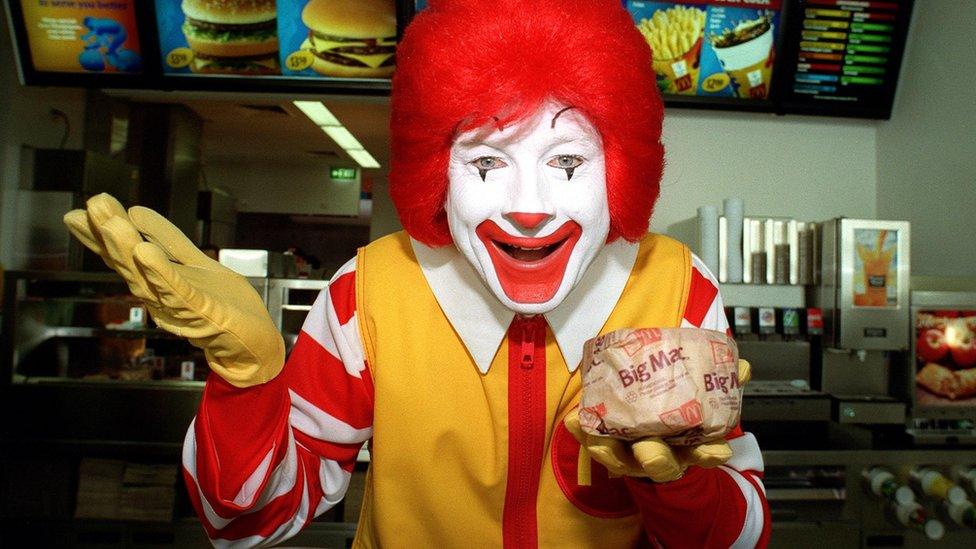The McDonald's drive-thru at 30: A journey back to an exotic experience
- Published
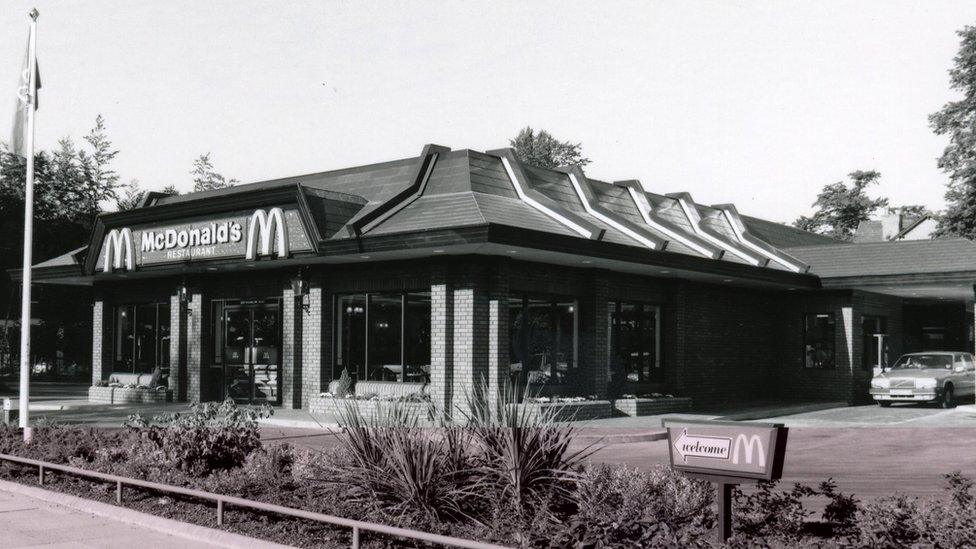
The UK's first drive-thru McDonald's - it opened in Fallowfield, Manchester, in late 1986
It is 30 years since McDonald's opened its first UK drive-thru - 1986 being a year of firsts for a brand that now has 1,200 restaurants across Britain. The figures show consumers really are "lovin' it", yet the concept is also ubiquitous - a familiar, disposable and repeatable experience. So how was it for customers when McDonald's was still new? Was what is now commonplace ever thought a thrill?
It is 1975. UK cinemas are showing an advert for a brand whose name, at this point, is principally linked in the national consciousness to a nursery rhyme farmer.
To the viewer, "golden arches" means nothing. They don't know chips by another name smell as sweetly. A Big Mac is just an oversized anorak.
The ad comes a year after McDonald's opens its first UK restaurant in Woolwich, London. Few Brits, relatively, have visited. People are still using knives and forks. The past, as they say, is a foreign country - they do things differently there.
Fast forward to 1983 and there are 100 McDonald's restaurants in the UK. The odds remain against most people seeing one. They literally do not know what they are missing.
Then 1986 rolls around and three things happen to boost our acquaintance with the red-haired clown. In Middlesex, the first franchisee-run McDonald's opens. Another introduction is the Happy Meal, the very title of which suggests things have moved on from buying food to buying emotions - "eat this to feel like this". Chewing is so 70s. Things are now about experience.
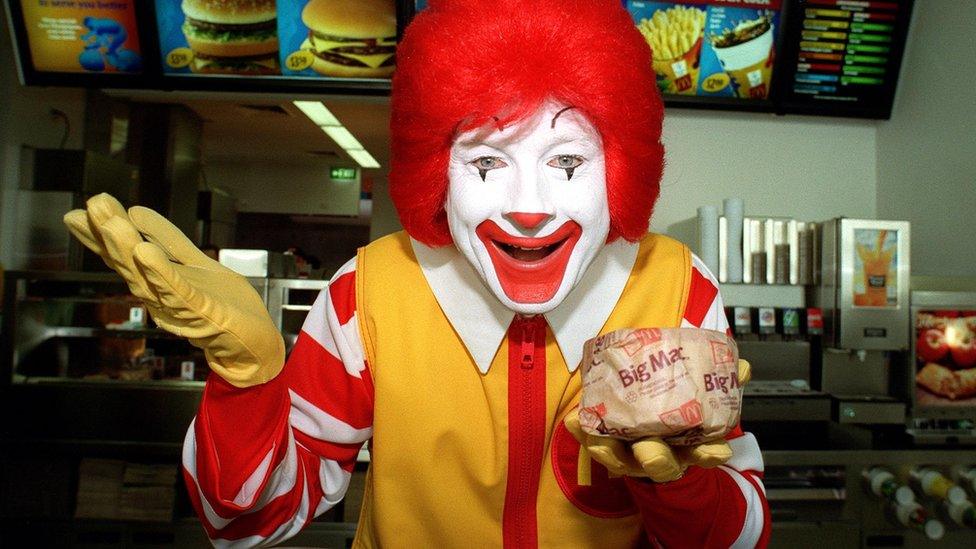
By 1986, Ronald McDonald - a symbol of the brand - is becoming more widely known, with four drive-thrus opening late in the year
The standout concept in late-86, though, is the drive-thru - the missing "o", "g" and "h" letting Brits know they are through the looking glass. Or at least in Fallowfield, Manchester, where the first one opened, quickly followed before the end of the year by drive-thrus in Dudley, West Midlands; Neasden, London; and Coventry.
"It seemed a wacky idea and one with technology my family didn't trust."
This is the memory of 2016 McDonald's customer Chris Hammond - a West Midlands man born in the 70s and raised in the 80s; the sweet spot for those who remember the brand when it was new and Britain was a thinner nation. These were days when the BMI index sounded like the Argos catalogue's fancy mate.
Chris gives an estimate of "mid-80s" for his first McDonald's visit, but it was not until as a teen in the 90s that he used a "space age" drive-thru, with its electronic ordering of goods via disembodied dialogue - a sort of early world wide web, overseen by teens in caps.
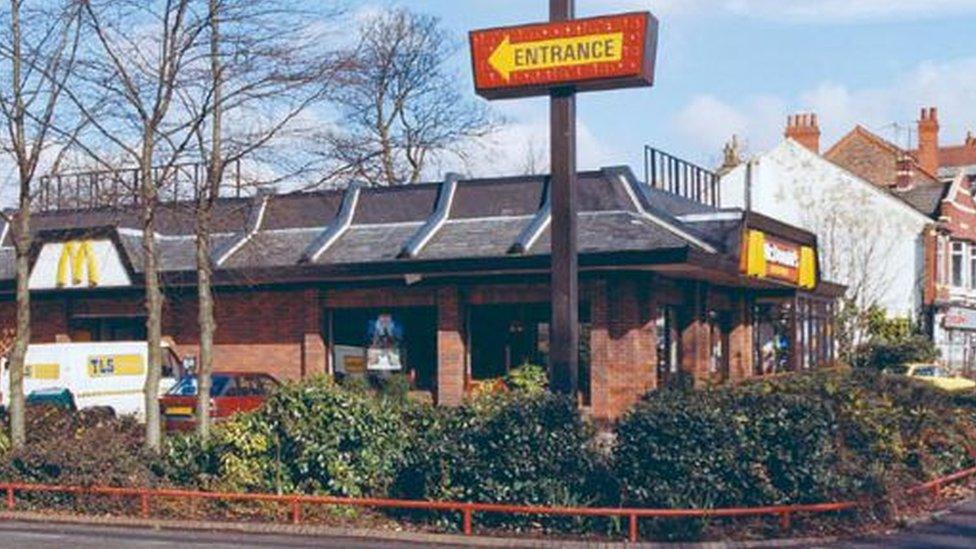
A restaurant in the 1980s - a decade in which the first UK drive-thrus opened
"I think we were suspicious of the drive-thru," he says. "And friends who did use them back then didn't quite know the purpose; their parents ordered the food but ate it in the car park. It was driving through for its own sake. Now my car has a cup-holder as standard."
Eighties child and Surrey resident David Jones, 41, has a similar memory. "Drive-thrus were other worlds that other people visited."
But what was it that put on the brakes and left people confused as to whether to take home the food? How could things have ever appeared "other" and "not for me"?

Formative years of McDonald's in UK
1974: First restaurant opens in Woolwich, London
1975: Ad appears on cinema screens
1982: Breakfast introduced to the menu
1983: Hundredth restaurant opens - in Market Street, Manchester
1984: Chicken McNuggets introduced
1986: First drive-thru restaurants open; the 200th restaurant opens in Ipswich; first franchisee-run restaurant opens; Happy Meals introduced
1988: CFCs removed from foam packaging; 300th restaurant opens in Dagenham

In the mid-1980s a visit to McDonald's was so unusual it created doubt over how to be and feel - uncertainty that rubbed up against a thrill now difficult to imagine. This was a place where up was down and even falsehood had an air of glamour.
"McDonald's was the first place I ever saw a fake plant," said David, nostalgic for lying yucca, glass and "curved corners". He said: "You can't imagine what a big deal the aesthetics were - staff in little white hats and food being eaten on two floors; this was not the chip shop, it was leaving Britain."
The difference scrambled people's brains. Before McDonald's and its ilk - with Britain still decades from the gastro pub - kids' experience of eating out was limited. And social eating tended to happen at home, or school, or a friend's house. Yet here was a restaurant where they did not have to keep their legs still. It was a picnic inside. Christmas in July. The chance of a lunchtime.
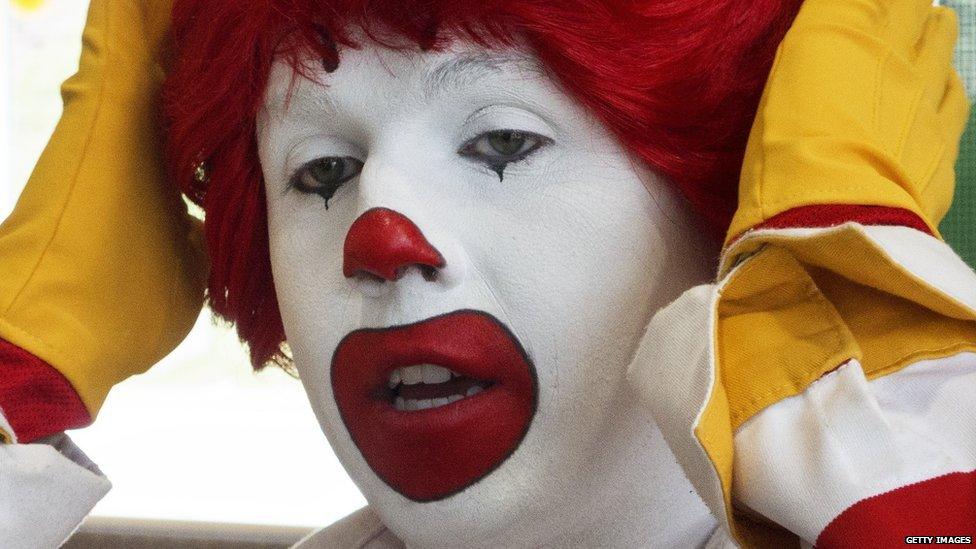
Customers looking back on the 1980s recall the newness and difference of McDonald's leaving them unsure what to do
David thought once-a-year McDonald's "exotic", the Fillet-o-Fish "posh" and the taste secondary to going at all. Chris remembers it as an "event", an experience and destination unto itself. One that served a cultural shift by way of "a cowboy's food".
"At first," he said, recalling plastic toadstools for seats, "McDonald's seemed to be only about children's parties - I couldn't conceive of people just going for something to eat, but after a while, I was one of them.
"Before, I had been used to knives and forks, even ashtrays - that was Wimpy - but here you were out the house, yet using your hands without a plate - practice I thought was restricted to the home. And yet my parents felt the need to formalise it all by choosing what amounted to a starter, a main course and pudding."
Mark Stinton, 40, from Birmingham, had the same experience and it meant hotter-than-the-sun apple pies every time he went - in those days as a "treat". "The pie was used, I think, to make it seem a proper dinner - there was a will to treat McDonald's as a complete meal rather than hangover food."
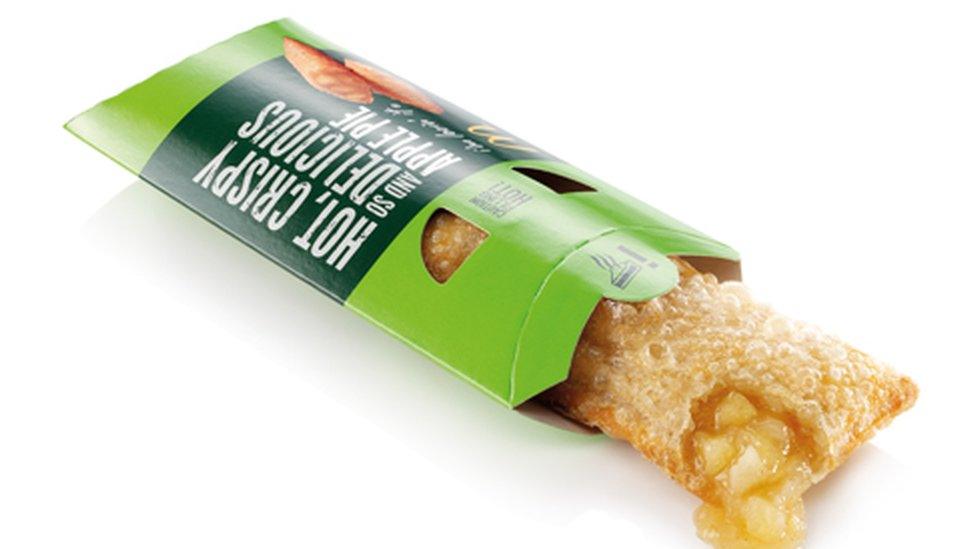
One 80s consumer remembers his parents trying to formalise visits to McDonald's by way of ordering "pudding" - molten apple pie
But the balance of formality and convenience in the 80s played havoc with concepts of time. Fast food? It was not that simple. The fare may have had the delivery of a fast bowler but the customer was not in and out - this was the Test match batting of dining; an experience people did their best to stay inside.
"We were never sure," Chris said, "about how quickly to get away. If anything, it was the opposite of fast food and we hung around. You wanted it to feel like it was a thing you'd set out to do."

How fast is fast food?
Time. It was once the marker against which party kids had to name the ingredients in a Big Mac. List the list quickly and win a prize. Above all others, it is the product the nostalgic are most excited to recall.
The Big Mac - invented in 1967 by a US franchisee - is still going, of course. But it is now a background thing, rarely to raise an eyebrow, save for its discarded pickles; discs of funny cucumber left on a table top as if trying to relieve it of tired eyes.
But 30 or more years ago, the Big Mac drew kids' gasps. In one sesame-seeded stack it seemed to rip up the rulebook. It was the knickerbocker glory of cow. With its two burgers and bread bridge, the top half mirrored the bottom; a sort of bun and beef palindrome for mouths that - crucially - were milk teeth-free.

US franchisee Michael "Jim" Delligatti invented the Big Mac in 1967
"I thought Big Macs were only for truckers and wrestlers," Chris said. "I thought there must be a rule about it."
Mark and David did not try one until their teens, both having once also suspected a literal pecking order upheld by a man in a wig and yellow dungarees. "As a child," Mark said, "I was at a McDonald's party and, from my seat in a replica ship, I spotted a kid eating a Big Mac. I remember it being frowned upon by everybody - it was so gauche, he may as well have had a sparkler sticking out the top."
It was typical of an early McDonald's experience: Confusion, newness and thrill all at once. It sounds like love. Or at least "lovin' it". "Lovin' it" in a different century.
- Published30 November 2016
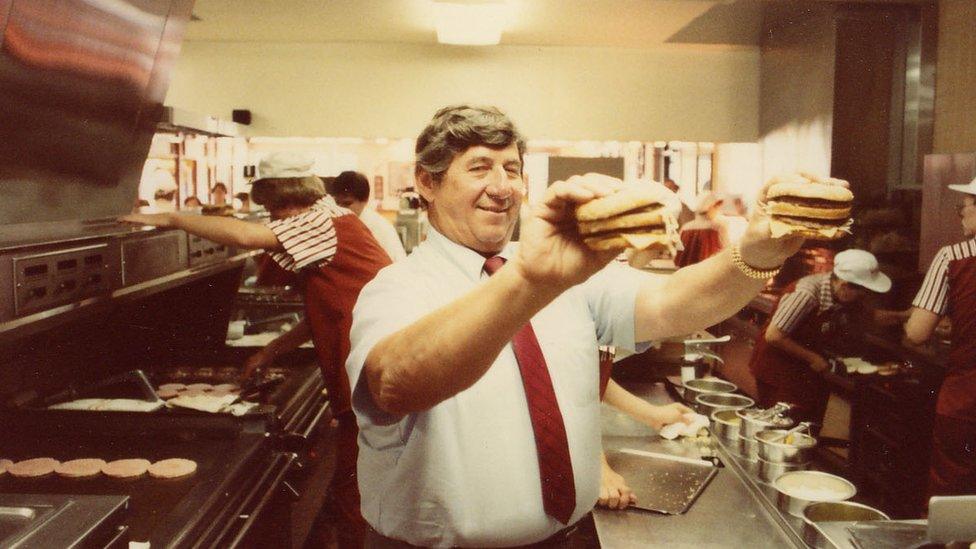
- Published11 March 2016
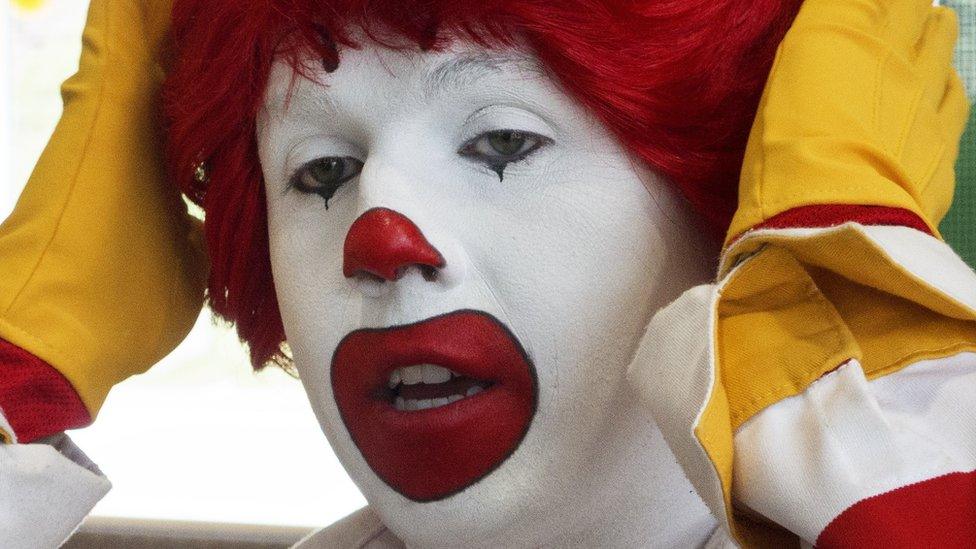
- Published1 March 2016
